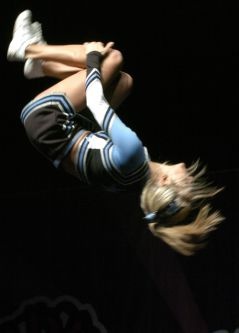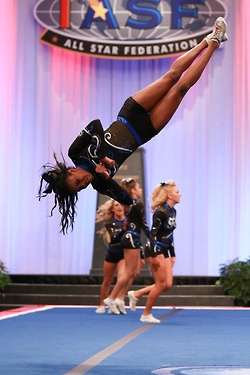Cheerleading is a dynamic and captivating sport that requires a combination of athleticism, precision, and teamwork. One crucial aspect of cheerleading that adds flair and excitement to routines is cheer tumbling. In this comprehensive guide, we will delve into the world of tumbling, exploring different types such as standing and running. Whether you’re a cheerleader looking to enhance your skills or a coach seeking to guide your team, this post is your go-to resource. Let’s get into the details!
Table of Contents:
- Understanding the Basics of Cheer Tumbling
- Mastering Standing Tumbling Techniques
- Perfecting Running Tumbling for Dynamic Routines
- Tumbling in Routines: A Showcase of Skill and Precision
- Safety First: Tips for Injury Prevention
- Conclusion
Understanding the Basics of Cheer Tumbling
The heartbeat of dynamic cheerleading routines, combines acrobatic skills to infuse energy and excitement. It’s more than flips and twists; it’s a choreography of precision and timing. To excel, grasp the foundational elements and body control essential for success.
Cheer tumbling is a symphony of flips, twists, and fulls that requires not just strength but also precision and timing. Mastering it involves understanding the dynamic interplay between the body and the forces at play, honing spatial awareness, and synchronizing movements within the team. Begin with fundamental skills like forward rolls and handstands, building a strong base for more advanced maneuvers. Tumbling is the art of athleticism and showmanship, transforming routines into captivating performances. Throughout this guide, we’ll explore techniques to help both beginners and experienced cheerleaders refine their skills, adding vibrancy to their routines. Get ready to soar – the adventure of tumbling awaits!
Mastering Standing Tumbling Techniques
Standing tumbling is a foundational element in cheerleading, showcasing the fusion of strength and balance. It originates from a standing position, and it serves as a focal point to highlight a cheerleader’s athletic prowess. In this section, we will explore essential standing tumbling techniques, breaking down the nuances of each move to provide valuable insights for cheerleaders and coaches looking to enhance their skills.

Back Handspring:
The back handspring is a foundational move that forms the basis of many tumbling passes. To execute a perfect back handspring, start with a strong stance, arms overhead, and propel yourself backward into a graceful arc. Precise hand placement and a swift push off the ground are crucial for achieving height and control.
Standing Full:
The standing full is a pinnacle of standing tumbling, requiring a combination of strength and rotational control. Initiate the twist from a standing position, utilizing core strength and arm positioning to achieve a seamless 360-degree rotation. Mastering the standing full enhances a cheerleader’s repertoire, adding sophistication to their routine.
Standing Back Handspring Through to Full:
Progressing further, the standing back handspring through to full combines the power of two back handsprings seamlessly transitioning into a full twist. It demands heightened precision and coordination, emphasizing the importance of maintaining momentum through each element of the sequence. A strong takeoff and precise arm movements are critical for success.
Back Tuck:
Elevating the complexity, the back tuck adds flair to standing tumbling. Begin with a strong takeoff, tucking the knees tightly to the chest and rotating backward before extending into a controlled landing. Focus on maintaining a tight tuck position and a quick, efficient rotation for a polished back tuck.

Standing Back Handspring Tuck:
This advanced standing tumbling technique involves seamlessly transitioning from a back handspring directly into a tucked position. It requires explosive power and swift transitions to execute the back handspring with precision and seamlessly transform it into a tucked rotation. A tight tuck position and controlled landing are paramount for a flawless standing back handspring tuck.
Perfecting Running Tumbling for Dynamic Routines
Running tumbling injects an extra layer of thrill into cheer routines, as athletes harness speed, agility, and coordination to embark on their tumbling pass. Starting with a dynamic sprint, this section explores the excitement of running tumbling, featuring a variety of passes that showcase the seamless fusion of athleticism and precision.
Running Tuck:
The running tuck showcases the cheerleader’s ability to execute a tucked rotation with grace and control while maintaining momentum from the running start. It’s a foundational skill that serves as a building block for more complex running tumbling passes.
Back Handspring Sequence:
Creating a rhythmic spectacle, the running back handspring sequence involves a string of back handsprings executed consecutively. This pass highlights the athlete’s endurance, strength, and ability to maintain precision in a sequence of dynamic movements.
Back Handspring Tuck:
Exhibiting agility and control, the back handspring tuck involves a powerful running start leading into a back handspring directly followed by a tucked rotation. Achieving a tight tuck position mid-air is crucial for a flawless execution of this dynamic tumbling pass.
Back Handspring Through to Full:
This advanced running tumbling pass involves a series of back handsprings fluidly transitioning into a full twist. The seamless connection between each element requires not only speed and precision but also a keen understanding of body positioning throughout the sequence.
Punch Front Through to Full/Double:
A breathtaking display of skill, the punch front through to full or double, involves a front flip seamlessly transitioning into a back handspring and culminating in a full or a double twist. This pass demands a combination of explosive power, spatial awareness, and precise timing to execute the sequence with finesse.

Cheer Tumbling in Routines: Skill and Precision
Cheer goes beyond individual skills, becoming a cornerstone that enhances team routines. In this section, we explore the seamless integration of tumbling into routines, emphasizing the importance of skill and precision for visually stunning performances.
Synchronized Passes:
Achieving synchronized tumbling adds precision and unity to routines, showcasing the team’s cohesive spirit.
Innovative Combinations:
Encouraging creativity in combining tumbling elements to add surprise and excitement to routines.
Fluid Transitions:
Emphasizing the art of seamless transitions between stunts, jumps, and tumbling for a harmonious performance.
Showcasing Diverse Skills:
Celebrating team members’ unique strengths by incorporating a variety of tumbling skills into the routine.
Precision in Execution:
Focusing on the details to ensure each tumbling pass contributes to the overall precision and excellence of the performance.
Safety First: Tips for Injury Prevention

Safety takes precedence in cheer tumbling, and this section prioritizes injury prevention techniques for a secure training environment. Emphasizing proper warm-ups, conditioning exercises, and spotting protocols, it equips coaches and cheerleaders with valuable insights to push boundaries safely.
Proper Warm-ups and Stretches:
Highlighting the importance of thorough warm-ups to prepare the body for the demands of tumbling. Dynamic stretches and targeted exercises enhance flexibility and reduce the risk of injuries.
Conditioning Exercises:
Focusing on strengthening core muscles and improving overall fitness to provide a solid foundation for executing tumbling skills. Conditioning plays a crucial role in injury prevention and enhances the athlete’s ability to perform with control.
Spotting Protocols:
Introducing effective spotting techniques for coaches to support cheerleaders during skill development. Spotting not only builds trust but also adds an extra layer of safety, particularly when athletes are pushing their limits to master new skills.
Creating a Safe Training Environment:
Providing insights into establishing a safe training space that minimizes potential hazards. From proper equipment usage to maintaining a clean and organized practice area, creating a safe environment is fundamental to injury prevention.
Balancing Progress and Safety:
Encouraging a balanced approach to skill progression, where athletes challenge themselves while respecting their physical limitations. Striking this balance ensures continuous improvement without compromising safety.
Conclusion:
In conclusion, tumbling is a captivating aspect of cheerleading that requires dedication, practice, and precision. Whether you’re a beginner or an experienced cheerleader, mastering the art of tumbling takes time and commitment. By incorporating the techniques and tips outlined in this guide, you’ll be on your way to becoming a skilled tumbler, adding an extra layer of excitement to your cheerleading journey.